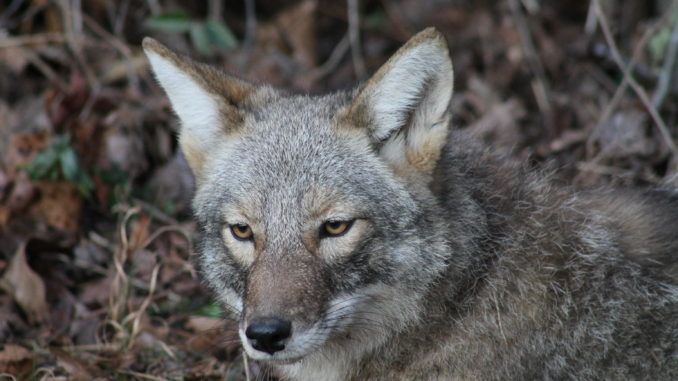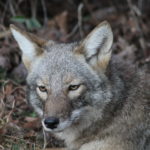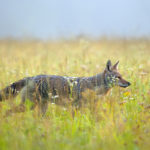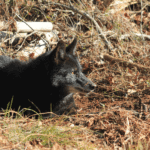
Sumter National Forest in the Midlands and Upstate offers hunters a chance to extend their seasons into the winter by removing a nuisance predator — the coyote.
The woods were silent, except for the crying sound of a wounded rabbit. Wailing and squealing. Pause, more squealing. Another pause led me to stare down an abandoned logging road that meandered through the Sumter National Forest in Newberry County. My shotgun rested on my shoulder as I surveyed the woods and the lane, looking for any motion that would give away a coyote coming my way. As quickly as it started it ended; the song dog appeared, saw the decoy and came in on a dead run. The Hevi-Shot stopped him at 30 yards just before he pounced on the decoy.
As deer season ends, many hunters are looking for other ways to pursue game animals across South Carolina. One activity growing in popularity is predator hunting. And during cold month, bringing coyotes to a call is a great alternative to winter blues.
The coyote gets a lot of bad press — some if it is justified — but as far as a challenging hunt, calling predators is as good as it gets. As the apex predator of the Piedmont and Upstate, coyotes present hunters with a challenging and quality trophy. Moreover, when you consider the impact of taking a few coyotes from your hunting grounds, it’s a win-win situation for hunters.
The Sumter National Forest is comprised of three districts: the Enoree District encompassing Newberry, Union, Chester, Laurens and Fairfield counties; the Long Cane District covering Abbeville, Edgefield, Greenwood, McCormick and Saluda; and the Andrew Pickens District covering Oconee County. In total, the Sumter National Forest encompasses approximately 371,000 acres.
While the tracts are scattered and have been reduced somewhat over the years, there are still ample opportunities to access and successfully harvest coyotes.
But the Enoree and Long Cane districts provide the best opportunities.
According to Jay Butfiloski, furbearer project coordinator for the S.C. Department of Natural Resources, hunters took approximately 32,204 coyotes in South Carolina in 2011. Population numbers are at best a guess, since there is no hard data to show the actual number of coyotes.
“We do know that we have a healthy population of coyotes in every county of the state, and this population is growing.” Butfiloski said.
There aren’t funds available to do a hard study on the state’s coyote population, but estimates show that the Piedmont portion of the national forest holds a very healthy and huntable population of coyotes. Surveys indicate that out of the Enoree District, 1,599 coyotes were harvested in Laurens County, 1,225 in Newberry, 1,204 in Chester, 997 in Fairfield and 727 in Union county. In the Long Cane District, 955 were harvested in Saluda County, 810 in Edgefield, 727 in Abbeville, 706 Greenwood, and 374 in McCormick.
Tactics for hunting coyotes depend largely on your location. Many areas of the national forest are dense woods. Logging roads, forest roads and access roads all present possible locations for setting up to call in song dogs. Many top-notch coyote hunters favor being in more open terrain, preferring to have a great distance to see coyotes coming from as far as possible — which isn’t always possible in dense woods. While it’s different, it certainly isn’t impossible to hunt and kill coyotes in these conditions.
One of the challenges hunters face is the legality of weapons to be used. The SCDNR’s regulations limit weapons used to take coyotes (and armadillos) on public lands to those “allowed for the current open season.”
After deer season ends on Jan. 1, hunters are limited to weapons that are legal to hunt small game: shotguns with shot no larger than No. 2, .22 of smaller rimfire rifles/handguns and primitive muzzle-loading rifles of .40 caliber or smaller, and archery equipment with small-game tips.
Coyote hunters who choose rimfire rifles tend to choose either the .17 HMR or the .22 magnum, both of which are more than capable of killing coyotes at reasonable ranges. Most, however opt for a 12-gauge shotgun loaded with the maximum size shot allowed; many ammunition companies are manufacturing loads designed to kill predators.
For hunting in the thick woods of the Sumter National Forest, many prefer a 12-gauge shotgun loaded with Hevi-shot’s “Dead Coyote” in 3- or 3 1/2-inch shells. From personal experience, that load will roll a coyote at extreme ranges.
These canines are intelligent animals, keenly aware of their surroundings. If a hunter thinks he can pull up to a location, blow a wounded rabbit and kill coyotes, he is in for an awakening. Scent control, stealth and head-to-toe camouflage are a requirement.
Setting up is as important as good calling. Getting into a likely location requires stealth. Coyotes are notorious for circling downwind of a caller, so having good visibility of your area is crucial. Most good turkey hunters successfully kill coyotes because the techniques are similar.
Find a good location, set up against a good tree and get comfortable; while some song dogs will respond quickly, most will take some time.
P.J. Perea, a dedicated predator hunter who also is executive editor of publications at the National Wild Turkey Federation, said he sits a minimum of 45 minutes at each stand.
“Some dogs come in quick, but most, especially those in the woods, come a lot slower,” Perea said. “I like to set up, let the woods get good and quiet. Then, if I am in a heavily hunted area, I use sounds that I think other hunters haven’t used.”
Perea will often use the old standby of a dying rabbit, but more often than not in January and February he prefers howls and other coyote sounds to get them interested.
“A lot of hunters make the mistake of using puppy sounds or fawn distress in January,” he said, nothing that coyote puppies are at least nine months old and fully mature, and there are no fawns running around in January.
“I like to start with howls, and barks to see if I can get a response. If I get a response, then I feel a lot more confident I can call that coyote in,” Perea said.
He uses both electronic calls and manual calls, depending on the situation.
“I feel like the e-callers give me more versatility, but I prefer hand calls to close the deal,” he explained. “Learning to use them is the key. There is a lot more to it than just blowing on a call; it has to sound like something.”
Perea provided an example of one of his normal strategies.
“I normally start with a howl to see if I can get them interested, then follow this with a ‘food’ call such as a high-pitched rabbit or distress feral cat, or even a distressed chicken,” he said, explaining that “many of the ‘off-beat’ calls seem to work well.”
He adapts if hunting pressure has mounted in the area.
“If (I am) calling in an area that has seen some hunting pressure, you have to use calls the dogs haven’t heard before,” Perea said, referring to many sounds found on electronic callers, including the distressed chicken, feral cats, goats and cattle calls. “Coyotes are curious and will come to a lot of calls, so don’t get stuck with the same old rabbit in distress.
“Be willing to try a lot of different calls.”
Perea likes to call for five minutes, then sit silently for several minutes before repeating the calling sequence. This will often bring in several at the same time.
Coyotes hunt by scent and sight; it’s common for them to circle downwind to try and pick up the scent of the caller. That makes it imperative that hunters thrive to hide their own scent.
“Coyotes will come to within a hundred yards and will circle downwind, so sent control is critical,” he said.
The Sumter National Forest is loaded with coyotes, and for hunters looking to protect their deer herds and add some excitement in the winter, it’s hard to beat calling predators.
Coyotes are here to stay, and hunters who like a real challenge will find that calling to these animal will ignite a new passion of hunting. With thousands of acres available, why not get out there and start calling to song dogs?
DESTINATION INFORMATION
WHERE TO GO — The Sumter National Forest covers approximately 371,000 acres in three regions. Coyote hunters should concentrate on the Enoree and Long Cane districts. WMA rules apply to all hunting in these areas. The Enoree Ranger District contains land in Union, Laurence, Newberry, Fairfield and Chester counties.
WHEN TO GO — South Carolina has no closed season for coyotes and no bag limit.
TECHNIQUES/EQUIPMENT — Calling using electronic or manual callers imitating rabbits, feral cats, coyote pups or chickens in distress, plus coyote barks and howls is the accepted way to hunt song dogs. The set-up is much like a turkey hunter’s: put your back against a tree, in camouflage, but pay attention to scent control as if you were a deer hunter; coyotes will often circle to approach a caller downwind. As far as weapons, .22 magnum rimfire and .17 HMR are popular and legal calibers, a 12-gauge shotgun with shot no larger than No. 2 is an alternative.
MAPS — See www.fs.fed.us or www.dnr.sc.gov/mlands/directions?p_id=177 for the Long Cane District. For the Enoree District, visit www.dnr.sc.gov/mlands/managedland?p_id=178.
ACCOMMODATIONS — South Carolina Association of Visitor Bureaus (www.discoversouthcarolina.com).





Be the first to comment